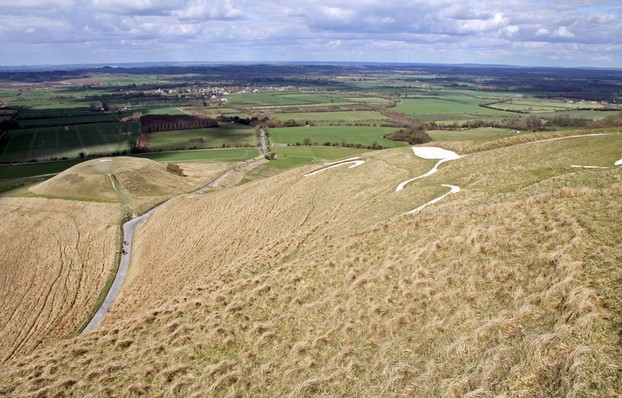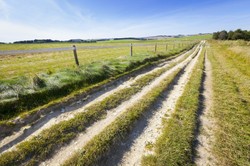A white snake across a green hillside, says the poet Edward Thomas of a chalk footpath. He was speaking of one of the many white serpentine ways that criss-cross England's downlands, downs being a term for the chalk hills that stretch across southern England. It was often said that the Romans gave us roads, but this is a myth born of classical snobbery, the belief that the Greeks and Romans were a civilising force among hordes skin clad savages. Forget the fact that the Romans had gladiator fights while the Celtic "savages" did not! There were roads in Britain long before Rome, and archaeologists have found traces of some beneath the Roman roads, showing that the Romans in some cases simply improved existing paths.
The most ancient long distance chalk path known in Britain is the Ridgeway, which is part of the longer Ickneild Way, that runs across southern Britain from Salisbury Plain in Wessex to Norfolk. The word Ickneild may be linked to the Celtic tribe the Iceni, those who were led to their doom by Boudicca [Boaddiccea] as they rebelled against atrocities by the supposedly civilized Romans. Thus it links several economically important parts of Roman Britain: Salisbury Plain, the site of Stonehenge and its rich ritual landscape; the Thames Valley ;and Norfolk, always an area with a rich pastoral economy and good trading connections across the North Sea.
The Ridgeway is that part of the Ickneild way that runs along the chalk ridge of the Downs. There was in ancient times a great advantage to having a route along the chalk ridge, it was dry. When people see the well-drained and well farmed land of Britain they tend to think that it was ever thus,but they err, for Britain is a wet place, and thus the valleys were often muddy. Many were also forested, making travel arduous. Furthermore, the chalk ridge had advantages, the open land meant that you could see enemies coming, and there were hill forts on the route, which meant that there were places for traders to stay and even take refuge.
The route is now a single track, but in ancient times it was a range of routes taken across the country, roughly parallel with each other. It undulates along the gently rising and falling downs, making for a pleasant and peaceful walk.The part which is known to be very ancient runs for eighty seven miles from Overton Hill near the ancient sacred site of Avebury, A stone circle once larger than Stonehenge, to the Goring Gap, a pass in the Thames Valley where the valley narrows as it goes through an ancient glacial spillway.
Robert Macfarlane in his wonderful book, the Old Ways, [p291] describes the Ridgeway as arguably the most sacralized terrain in Europe, a place of vast devotional interventions in the landscape:megaliths and henges, long and round barrows,and the "cryptically simple edifice" of Silbury Hill, a man-made hill erected for a ritual purpose possibly connected with the rituals of Stonehenge, which is visible from its summit. Macfarlane regards the Stone Age landscape of the Ridgeway as landscape theatre and observes that walking is crucial to the perception of it. The approach is of great importance. Merely to whizz along on a motorbike kills the appreciation, you need to draw nigh at walking pace so as to come upon a a slow realization of the sacred significance of the place. Just as fast food rarely is fine dining, so fast experiences are only lightly digested, wheres to be appreciated an experience sometimes must come slowly. Profundity takes time.







 TheThousand Year Gardenon 11/26/2025
TheThousand Year Gardenon 11/26/2025
 Women of the Gospelson 10/11/2025
Women of the Gospelson 10/11/2025
 Religious Gardenson 08/25/2025
Religious Gardenson 08/25/2025
 Doctor of the Church: John Henry Newmanon 08/03/2025
Doctor of the Church: John Henry Newmanon 08/03/2025



Comments
The landscape was too daunting, there we're no resources to exploit, and The natives were fierce.
Thank you for your comment below, in answer to my previous observation and question.
That the Romans "never went" to highland Scotland intrigues me.
Is that because of the biogeography intimidating the Romans albeit oft identified as fearless and practical?
The highlands is Scotland, where the Romans never went.
The computer crashed before I commenced another component to my question below.
Your answer two comment boxes down alerts us to "tracks across Britain years before the Romans arrived."
What is the British area least-tracked pre-Roman activity?
Thank you for your comment below, in answer to my previous observation and question.
Tracks across Britain before Roman road-building years intrigue me.
What is the British area most-tracked pre-Roman anciently?
There were tracks across Britain years before the Romans arrived. I have walked a stretch of one, the Portway, which crosses the Long Mynd in Shropshire.
Thank you for your comment below, on Apr 8, 2023, in answer to my previous, previous-day observation and question on Apr 7, 2023.
Romans building roads over Briton-built roads intrigues me.
Might the Romans already have been known as road builders or might Roman years in the British Isles have motivated that mastery?
Historians do not describe ancient Britons as Celts. The attribution of Celts to the Britons was the product of Victorian a ntiquarians.The road builders were simply Britons.
The first paragraph to your first subheading, Old Roads, considers that "There were roads in Britain long before Rome, and archaeologists have found traces of some beneath the Roman roads, showing that the Romans in some cases simply improved existing paths."
That road-building commitment makes me think of the Inca Empire in ancient South America.
The Inca peoples perhaps rivaled the Romans in that commitment. They seem to have come from nowhere -- one of my professors with a double doctorate in Anthropology and Linguistics suggested errant Mayans -- and to have hidden their native language.
Runa Simi ("the language of the people") -- so unkindly called Quechua by the Conquerors since that word means "to steal" -- was the language of one of the Inca's ruled populations.
Perhaps the Inca too worked their roads across pre-existing paths of no longer known peoples.
Who would the peoples -- Celts? -- have been who built the roads that Romans would take credit for?
You make me realize that I am fortunate. I have hiked alone in Britain,Ireland, Crete, Norway and Portugal and never seen any trouble or suffered any attempt at robbery.